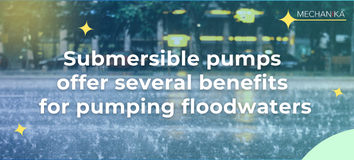Submersible pumps offer several benefits for pumping floodwaters, making them a popular choice in flood management and emergency response scenarios. Some of the key advantages of using submersible pumps for pumping floodwaters include:
- Efficiency: Submersible pumps are designed to be highly efficient, with the motor and pump unit located underwater. This design reduces friction losses and improves hydraulic efficiency, allowing them to move large volumes of water quickly.
- Space-saving: Submersible pumps are compact and do not require a separate pump house or structure. They are installed directly in the flooded area, saving valuable space and minimizing the need for complex installation setups.
- Ease of Installation: These pumps are relatively easy to install, requiring less extensive setup compared to traditional above-ground pumps. They can be quickly lowered into the water and connected to the discharge piping.
- Reduced Priming: Submersible pumps are self-priming, which means they are capable of evacuating air from the pump casing and suction pipe without manual intervention. This feature simplifies the startup process and helps maintain continuous pumping.
- Clog Resistance: Submersible pumps are less prone to clogging compared to some other types of pumps, as they are typically designed to handle solids and debris that may be present in floodwaters.
- Minimized Noise and Vibration: Submersible pumps operate underwater, which helps reduce noise and vibration levels. This can be beneficial in residential or urban areas where noise pollution is a concern.
- Reliability: These pumps are built to withstand immersion in water for extended periods, making them reliable in flood scenarios. They are often made with corrosion-resistant materials to enhance their durability.
- Safety: Submersible pumps are safer to use in floodwaters because the electric motor and other components are isolated underwater, minimizing the risk of electrical hazards.
- Flexibility: Submersible pumps can be used in various water sources, including ponds, lakes, rivers, and basements. They are versatile tools that can adapt to different flood situations.
- Remote Operation: Some submersible pumps can be operated remotely, allowing for better control and monitoring of the pumping process. This feature can be particularly useful in challenging or hazardous environments.
- Energy Efficiency: Submersible pumps often feature energy-efficient designs, which can help reduce operational costs, especially during extended pumping operations.
- Rapid Response: Submersible pumps can be quickly deployed to flood-affected areas, helping to mitigate damage and control water levels more effectively.
It’s important to note that while submersible pumps offer numerous benefits, their effectiveness also depends on factors such as pump size, capacity, and the specific characteristics of the floodwaters. Proper planning, selection, and maintenance of the pumps are essential to ensure optimal performance during flood events.
FACEBOOK : MECHANIKA

